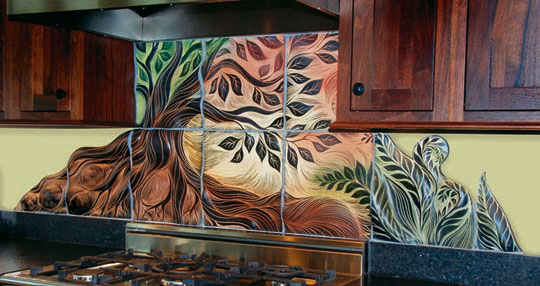Q&A: Colors in Ceramic Sgraffito Art
Curious tile-lovers have a lot of questions about how we make our ceramic sgraffito art. So, we've collected some recent questions about color and glazes to answer here in our blog. This Q&A session focuses on color. Color – bright, vibrant, inviting color – is as much a part of Natalie Blake Studios’ distinctive ceramic art as sgraffito carving. While this isn't quite an article on how to glaze ceramics, we hope it will ease (or rather, pique) your curiosity about our most colorful ceramic sgraffito work. Here goes!
Q:How do you achieve the contrasting color where you have carved? I am sure you don't have that many different colors of clay.George H., via email
A: Great question, George, especially because it lets us start at the very beginning. To achieve that high contrast, we apply a coating of slip to unfired porcelain clay before beginning sgraffito carving. Our handmade tile designs are created by carving through the top slip covered layer. After the ceramic is bisque-fired, we apply colored glazes and fire again. The colors only show in the carved areas, and the dark slip that remains blends with the layer of glaze and shows through as black or some range of grey depending on what glaze it is blending with and how thickly the glaze is applied.
Handmade Ceramic Bowl
Q: How did you get that Melon color, it’s spectacular! Martha A., via Facebook
A: We have done a lot of testing to find glazes that are compatible with our claybody and which the slip blends well with. All this testing has resulted in a huge stock of more than 30 different colored glazes that we choose from to color our sgraffito ceramics. This bowl looks melon-y thanks to an exterior glazed in jade and a watermelon interior glaze.
Color, Glazing Handmade Ceramic Art
Q: How do you manage to get the shades of a single colour so evenly spread over a tile?Lata D., via Facebook
A: To apply our colored glazes, we use an industrial paint sprayer like the ones used to paint cars. It is essentially an airbrush, spraying a “mist” of glaze that our staff can control to change the intensity of the color. We spray one glaze at a time across the tiles, applying each glaze where we want that color on the mural, similar to painting. Spreading the color evenly and achieving smooth blending is an art that we are continually perfecting!
Got more questions about colors and glazes? Ask away in the comments or on Facebook, and tell us what you'd like to see on the next Q&A blog about our handmade ceramic art.



